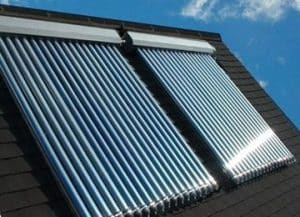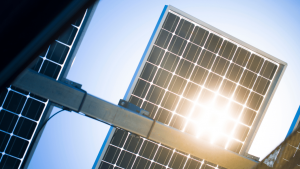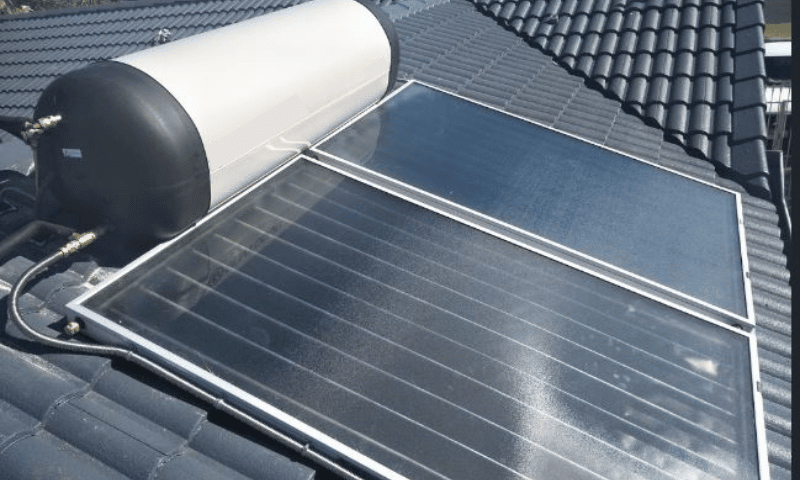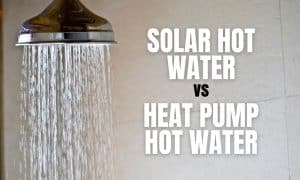Hot water heating is a huge source of household energy consumption in Australia. Solar water heaters are present in most Australian homes today. In this post, we dive into solar water heating, comparing the efficiency and practicality of two primary technologies: solar thermal and solar photovoltaic (PV) systems.
Understanding these systems can help homeowners make better decisions to effectively harness solar power for their water heating needs.
Solar thermal systems

The concept of solar thermal has been around for a long time. However, compared to solar PV panels, the large-scale adoption of concentrated solar thermal (CST) for electricity generation is still early in Australia. CST utilises solar collectors to focus sunlight onto a receiver, which is converted into heat using mirrors or lenses. This is mainly due to cost factors.
Despite that, there are ongoing advancements in CST storage, which could make it more prominent. Last year, Australia’s CSIRO achieved a breakthrough by reaching a milestone temperature of 803 °C at the receiver, paving the way for cost-effective renewable energy storage and potential global adoption.
The country’s most common type of solar thermal system is domestic solar water, which uses solar energy to heat water for showers, baths, and laundry. Most Australian homes with solar water heaters use conventional flat plate thermosyphon systems.
Other low-temperature solar thermal appliances include solar crop drying, solar ponds, and solar air heating, but all are small-scale.
Solar PV system

Solar PV systems turn sunlight into electricity and are made from a semiconductor material that triggers an electrical charge and the flow of DC electricity. However, they aren’t directly used in traditional solar hot water systems. This is because conventional solar hot water systems use solar collectors that capture heat directly from the sun, not electricity. These collectors heat water stored in a tank for later use.
Still, solar PV systems can be indirectly involved with hot water heating in two ways:
- Solar diverter with electric hot water system: This uses a solar diverter to redirect excess electricity from rooftop solar panels during sunny periods. Instead of sending it back to the grid, the diverter channels this extra power to your existing electric hot water system, reducing reliance on grid electricity for heating water.
- Solar battery storage with a heat pump hot water system: This combines a solar PV system with a battery storage system and a heat pump water heater. The solar panels generate electricity, and any surplus is stored in the battery for later use. During off-peak hours, the battery can power the heat pump to heat water, efficiently lowering reliance on grid electricity.
Solar PV systems aren’t used to power traditional solar hot water collectors. Still, their excess electricity can be strategically used to heat water indirectly through a diverter with an electric hot water system or battery storage with a heat pump hot water system.
Which is the best option?
It all comes down to efficiency, and between solar PV and solar thermal systems, the latter is generally considered more efficient. This is because solar thermal collectors are explicitly designed to capture heat from sunlight, achieving up to 70% efficiency. The captured heat directly heats the water in the storage tank, minimising energy loss during the conversion. It is also cheaper to install compared to a solar PV system with battery storage for hot water.
The downside of solar thermal systems is they only heat water. This means they are not suitable for generating electricity for other household needs. Their hot water storage capacity may also be a factor, especially when it’s cloudy.
On the other hand, solar PV with heat pump or electric heater are efficient in a way that they are multipurpose. Since solar panels generate electricity, they can be used for appliances besides hot water heating. They can also be expanded to create more electricity for the entire household.
Unfortunately, solar PV systems still require converting solar energy to electricity first, then using the electricity to heat water. This leads to some energy loss during the conversion stages. They also have a higher upfront cost.
Solar thermal is the best option for direct hot water heating with maximum efficiency and a lower upfront cost. If you want a multipurpose system for generating electricity for your entire home and hot water and are willing to invest more upfront, solar PV with battery storage and a heat pump can be an excellent choice.
The good news is that things are changing, with solar PV costs decreasing while battery storage technology is improving. Therefore, solar PV with heat pumps is becoming more competitive. Additionally, advancements in heat pump technology are making them even more efficient at heating water.
Energy Matters has been in the solar industry since 2005 and has helped over 40,000 Australian households achieve energy independence.
Complete our quick Solar Quote Quiz to receive up to 3 FREE solar quotes from trusted local installers – it’ll only take you a few minutes and is completely obligation-free.










































